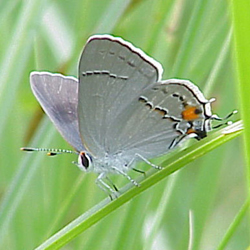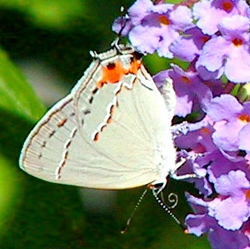Find a Butterfly
Gray Hairstreak
Strymon melinus
Named
Hubner, 1818

Identification
Wingspan: 1-1 1/4". No other hairstreak has the combination of gray underwing coloration and black, white, and orange median band on underwings. Acadian Hairstreak has underwing median band of separate black spots; Oak Hairstreak is light brown, not gray, beneath. Spring individuals are smaller and darker.
Distribution
Continent wide, from the southern Canadian border south to Venezuela. Absent from some southwestern desert areas. In New England, rarer northward and absent from northern Vermont, New Hampshire, and Maine.
Status in Massachusetts
Widely reported in eastern Massachusetts, sparingly in western Massachusetts, during the Atlas period. Historically, Scudder (1889)regarded the Gray Hairstreak as "not infrequent in the north." He noted its appearance at a number of Massachusetts localities, including several at considerable elevation, such as Mount Toby and Amherst Notch. Kimball and Jones (1943)listed only two records from Nantucket, while the species was said to be "widely distributed...though never abundant" at Martha‘s Vineyard. This last quote sums up the Gray Hairstreak‘s current status in most of eastern Massachusetts. The status in western Massachusetts is unclear; it is apparently less common there. Usually found singly or in very small numbers at any given locality. Maximum: 13 at Foxboro (Norfolk Co.), 15 July 1991.

Flight Period in Massachusetts
Double brooded, with butterflies from early May to mid June and from early July to late September in most years. Extreme dates: 12 April 1977, Woburn (Middlesex Co.), R. Robbins and 24 October 1994, Wellesley (Norfolk Co.), R. Forster.
Larval Food Plants
Known to feed on twenty-nine families of plants. Said to prefer legumes and mallows (Pyle, 1981) and to be an agricultural pest on hops, beans, and cotton (larva called Cotton Square Borer in Texas - Scott, 1986). In Massachusetts, definitely reported on the introduced Hound‘s Tongue (Cynoglossum officinale): Scudder; Round headed and Hairy Bush Clovers (Lespedeza capitata and L. hirta) and Panicled and Hoary Tick Trefoils (Desomodium paniculatum and D. canescens) fide Tom Dodd.
Adult Food sources
Attracted to many flowering species (26 during the Atlas period), from blueberries in spring to goldenrods in fall. The 13 at Foxboro on 15 July 1991, were all nectaring at Wild Indigo (Baptisia tinctoria).

Habitat
Open areas with scrub growth are preferred.
Life Cycle
EGG: Green, with delicate reticulation. OVIPOSITION: Eggs laid singly on flower heads. LARVA: Remarkably variable in color: straw, purplish white, pink, reddish brown, or green, with various other pale marks (Scott, 1986). CHRYSALIS: Brownish, with darker spotting.
Adults eclose from the chrysalis in early May and this small dark generation remains on the wing almost until the advent of the larger, paler summer brood. Males perch on favored shrubs throughout the afternoon hours. The flight is often fast and difficult to follow. The duration of the egg, larva, and chrysalis are not well documented. Very little, too, has been written about mating in the Gray Hairstreak. Opler and Krizek (1984) state that mated pairs have been seen only at night, after 10:00.
Account Author
Brian Cassie



